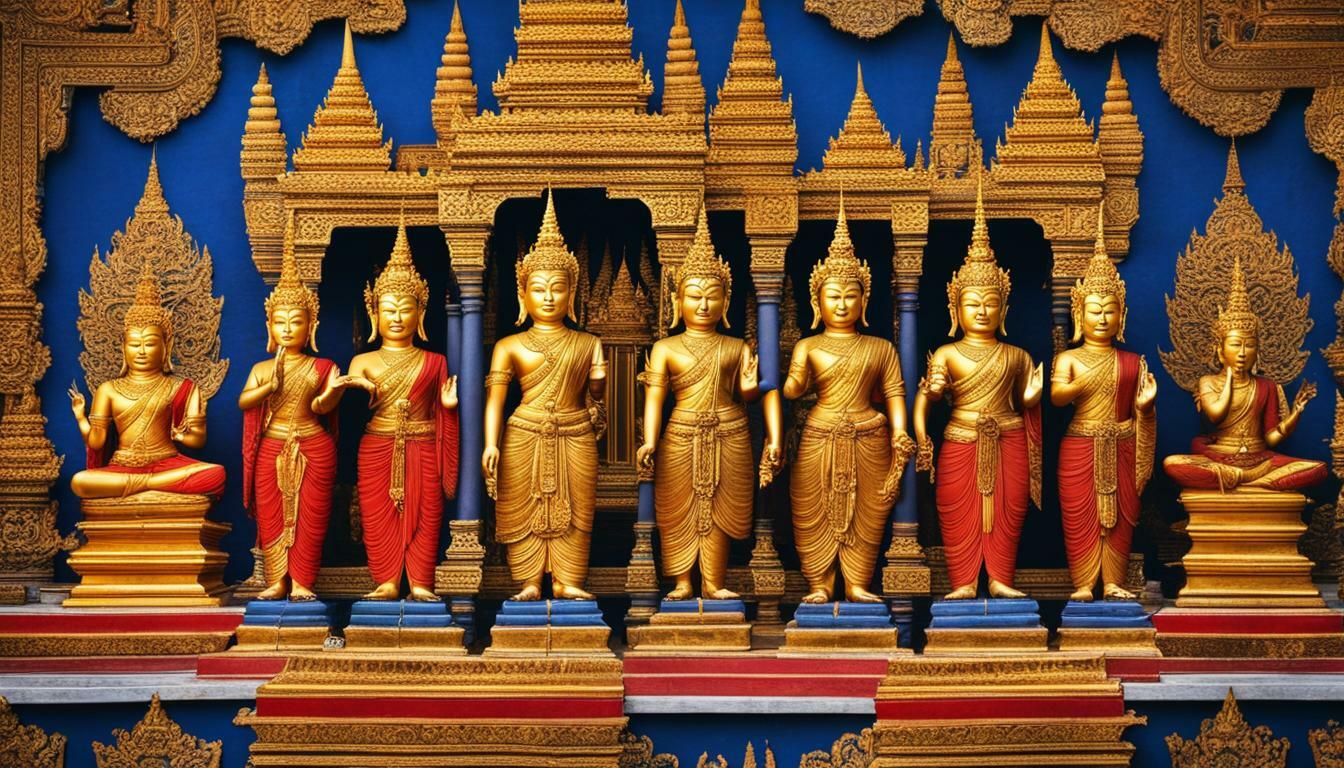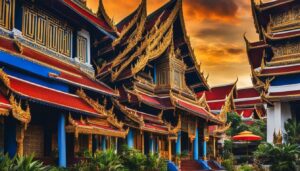Cambodia is a country with a rich linguistic heritage, but the official language spoken by the majority of its population is Khmer. Khmer is spoken by nearly 90% of Cambodians and plays a crucial role in government administration, education, and media.
Key Takeaways:
- Khmer is the official language of Cambodia, spoken by almost 90% of the population.
- English and French are also spoken in Cambodia, with English becoming the dominant foreign language since 1993.
- Other minority languages spoken in Cambodia include Cham, Vietnamese, Tumpoon, Lao, Jarai, Yue Chinese, and various Mon-Khmer languages.
- The linguistic diversity in Cambodia has a significant impact on its culture, traditions, and social interactions.
- Efforts are being made to preserve and promote the Khmer language, as well as to maintain linguistic diversity in the country.
The Khmer language in Cambodia
The Khmer language, also known as Cambodian, is the predominant language spoken by nearly 90% of the population in Cambodia. It holds an essential position in various aspects of Cambodian society, including government administration, education, and media.
In government administration, the Khmer language serves as the primary medium for communication, creating a sense of unity and cohesion among the country’s diverse population. It is used in official documents, public announcements, and interactions between government officials and citizens.
The Khmer language also plays a vital role in education. It is the medium of instruction in schools and universities across the country, ensuring that Cambodian students have a strong foundation in their native language. Moreover, it helps preserve the rich cultural heritage of Cambodia and facilitates the transmission of traditional knowledge to future generations.
Not only is the Khmer language deeply rooted in the cultural fabric of Cambodia, but it also shapes the media landscape. The majority of newspapers, magazines, radio broadcasts, and television programs are in Khmer, allowing Cambodians to access news, entertainment, and information in their native language.
| Language | Percentage of speakers |
|---|---|
| Khmer | Approximately 90% |
| Cham | 2% |
| Vietnamese | 2% |
| Tumpoon | 1% |
While the Khmer language dominates the linguistic landscape of Cambodia, it is worth noting that there are several other languages spoken in the country. These include Cham, Vietnamese, Tumpoon, Lao, Jarai, Yue Chinese, and various Mon-Khmer languages, reflecting the multicultural and diverse nature of Cambodian society.
In conclusion, the Khmer language holds immense significance in Cambodia, serving as the predominant language spoken by the majority of the population. It plays a crucial role in government administration, education, and media, contributing to the preservation of Cambodian culture and fostering a sense of national identity.
Other languages spoken in Cambodia
Besides Khmer, Cambodia is home to a variety of minority languages that contribute to its linguistic diversity. These languages play an important role in the cultural fabric of the country, reflecting the diverse ethnic groups that make up its population. Let’s take a closer look at some of these minority languages:
Cham
The Cham language is spoken by the Cham people, who are descendants of the ancient Champa kingdom. This Austronesian language is predominantly used in religious ceremonies and cultural practices.
Vietnamese
Vietnamese, a language belonging to the Austroasiatic language family, is spoken by the Vietnamese community in Cambodia. It has significant influence due to historical ties and the population of Vietnamese immigrants in the country.
Tumpoon
The Tumpoon language is primarily spoken by the Tumpoon people, an indigenous group residing in northeastern Cambodia. This Mon-Khmer language is part of the Palyu branch and is considered endangered.
Lao
Lao, a Tai-Kadai language, is spoken by the Lao community in Cambodia. It shares similarities with Thai and is primarily used by the ethnic Lao population living near the Cambodian-Lao border.
Jarai
The Jarai language is spoken by the Jarai people, an indigenous group living in northeastern Cambodia. This Austroasiatic language has its own unique script and is part of the Chamic subgroup.
Yue Chinese
The Yue Chinese language, also known as Cantonese, is spoken by the Chinese community in Cambodia. It has significant influence in business and trade, as well as cultural exchanges between Cambodia and Chinese-speaking regions.
Various Mon-Khmer languages
Aside from Khmer, there are several other Mon-Khmer languages spoken by different indigenous groups in Cambodia. These languages include Kuy, Mon, and Stieng, among others. While some of these languages are endangered, efforts are being made to preserve and revitalize them.
As you can see, Cambodia is a linguistically diverse country with multiple minority languages spoken alongside Khmer. This linguistic diversity contributes to the richness of Cambodian culture and highlights the importance of preserving these languages for future generations.
| Language | Language Family |
|---|---|
| Cham | Austronesian |
| Vietnamese | Austroasiatic |
| Tumpoon | Mon-Khmer |
| Lao | Tai-Kadai |
| Jarai | Austroasiatic |
| Yue Chinese | Sino-Tibetan |
| Various Mon-Khmer languages | Mon-Khmer |
English in Cambodia
English, since 1993, has become the dominant foreign language spoken and understood by many Cambodians. With the country’s increasing participation in the global economy and the influx of tourists, English proficiency has become highly valued and sought after. As a result, English language learning has gained significant attention in Cambodia, with educational institutions offering English courses and programs.
In addition to formal education, Cambodians also improve their English skills through self-study and interactions with native English speakers. Language exchange programs and community initiatives have emerged, providing opportunities for Cambodians to practice their English in real-life situations.
To meet the growing demand for English language skills, the Cambodian government has implemented various policies and initiatives to promote English education. English is now included in the national curriculum, and there is a strong emphasis on English language teaching in schools across the country. Additionally, the media, particularly television and radio, often broadcast programs in English, contributing to the exposure and immersion of the Cambodian population in the language.
English Language Proficiency in Cambodia
According to the English Proficiency Index (EPI), Cambodia ranks 61st out of 100 countries, indicating a moderate proficiency level. While English proficiency varies among different age groups and regions, the younger generation tends to have a higher level of English proficiency due to increased exposure and access to educational resources. However, it is important to note that English proficiency levels can differ significantly between urban and rural areas.
| English Proficiency Level | Description |
|---|---|
| Very High | Cambodians can communicate fluently and effectively in English, both in professional and social settings. |
| High | Cambodians have a good command of English and can communicate confidently on various topics. |
| Moderate | Cambodians have a basic understanding of English and can handle simple conversations and written texts. |
| Low | Cambodians have limited English proficiency, with difficulty in expressing themselves verbally and in writing. |
Opportunities and Challenges
The increasing English proficiency in Cambodia presents various opportunities, such as improved communication with international partners, enhanced employment prospects in sectors like tourism and business, and access to a wider range of educational materials. However, there are challenges to address, including the quality of English education, the digital divide in accessing online resources, and the need to ensure equitable opportunities for English language learning across all regions of Cambodia.
Despite these challenges, the growing dominance of English in Cambodia reflects the country’s globalization and its determination to adapt to an increasingly interconnected world. English has become a tool of communication, connecting Cambodians to the global community and providing them with opportunities for personal and professional growth.
French in Cambodia
Although English has surpassed it, French still maintains a presence in Cambodia due to its colonial legacy. French was introduced to Cambodia during the French colonial period, which lasted from the 19th century until the mid-20th century. During this time, French became the language of administration, education, and the elite.
Today, while Khmer is the official language of Cambodia, French is still taught in some schools and universities. It is also used in certain professions, such as law, medicine, and diplomacy. The influence of French can also be seen in Cambodia’s architectural heritage, where buildings with French colonial style can be found in cities like Phnom Penh and Battambang.
“French was introduced to Cambodia during the French colonial period, which lasted from the 19th century until the mid-20th century.”
However, it is important to note that the use of French has declined over the years, especially among the younger generation who are more inclined towards learning English. Nevertheless, French still holds a cultural significance in Cambodia and continues to be spoken by some older Cambodians.
French Language Schools in Cambodia
For those interested in learning or improving their French language skills, there are several language schools and institutes in Cambodia that offer French language courses. These courses cater to both beginners and advanced learners, providing a comprehensive understanding of the language and its nuances. Some popular French language schools in Cambodia include the Alliance Française, the French Institute, and the French-Khmer Translation Center.
| French Language Schools in Cambodia | Location | Contact Information |
|---|---|---|
| Alliance Française | Phnom Penh | Phone: +855 23 213 124 Email: info@alliancefrancaise.org.kh |
| French Institute | Battambang | Phone: +855 53 952 018 Email: info@institut-francais-cambodge.com |
| French-Khmer Translation Center | Siem Reap | Phone: +855 12 234 567 Email: contact@frenchkhmertranslation.com |
Through these language schools, individuals can not only learn French but also gain insights into the rich cultural heritage and history associated with the language. Learning French in Cambodia can provide opportunities for cultural exchange and open doors to various professions that require proficiency in both Khmer and French.
Conclusion on languages in Cambodia
The linguistic tapestry of Cambodia comprises Khmer as the official language, supplemented by English, French, and a multitude of minority languages. Khmer, spoken by nearly 90% of the population, holds a prominent position in government administration, education, and media. It serves as the foundation of Cambodian culture and identity.
In addition to Khmer, English has gained significant popularity since 1993, emerging as the dominant foreign language. It is widely taught in schools and used in business and tourism sectors. French, with its historical influence, also retains a secondary language status in certain circles, particularly among the older generation.
Moreover, Cambodia boasts a rich linguistic diversity, with various minority languages spoken alongside Khmer. Cham, Vietnamese, Tumpoon, Lao, Jarai, Yue Chinese, and various Mon-Khmer languages contribute to the cultural fabric of the country. These languages play essential roles in preserving unique traditions, fostering cultural exchange, and maintaining a vibrant multicultural society.
| Official Language | Additional Languages |
|---|---|
| Khmer | English, French |
Efforts are underway to preserve and promote the Khmer language, recognizing its importance in safeguarding national heritage. Embracing linguistic diversity is also crucial in celebrating Cambodia’s multiculturalism and fostering inclusivity.
Conclusion
Understanding the language landscape of Cambodia is essential to fully appreciate the country’s cultural richness and history. It is a testament to the resilience and adaptability of the Cambodian people, who have embraced multiple languages as part of their identity. By valuing and preserving these languages, Cambodia continues to shine as a linguistic melting pot, promoting cultural understanding and unity.
Language Impact on Cambodian Culture
Language plays a pivotal role in shaping Cambodian culture and is intertwined with various aspects of daily life. The official language of Cambodia, Khmer, serves as a symbol of national identity and unity. Spoken by nearly 90% of the population, Khmer is deeply ingrained in Cambodian society, influencing traditions, literature, and social interactions. It serves as a vehicle for preserving and transmitting cultural heritage from one generation to the next.
One of the fascinating aspects of Cambodian culture is its rich linguistic diversity. In addition to Khmer, the country is home to various minority languages, each with its unique traditions and customs. The Cham, Vietnamese, Tumpoon, Lao, Jarai, Yue Chinese, and various Mon-Khmer languages contribute to the vibrant tapestry of Cambodian culture, promoting multiculturalism and fostering cross-cultural understanding.
Language also holds the power to shape perceptions and worldviews. Through language, Cambodians express their emotions, convey their beliefs, and share their stories. It serves as a medium for artistic expression, with Cambodian literature and poetry reflecting the beauty and nuances of the Khmer language. From ancient epic tales to contemporary works, literature holds a special place in Cambodian culture, providing valuable insights into the country’s history and values.
Impact on Education and Communication
Beyond cultural significance, language also influences education and communication in Cambodia. Khmer serves as the primary medium of instruction in schools, ensuring that students develop a strong foundation in their mother tongue. However, with the growing prominence of English as a global language, there is an increasing emphasis on bilingual education to equip students with the necessary language skills for the future.
In conclusion, language serves as a powerful force in shaping Cambodian culture. From preserving cultural heritage to promoting multiculturalism and fostering cross-cultural understanding, the linguistic landscape of Cambodia reflects the rich diversity and traditions of its people. By appreciating the significance of language in Cambodian society, we gain a deeper understanding and appreciation for the country’s unique cultural identity and heritage.
Language Preservation in Cambodia
Various initiatives are in place to safeguard the Khmer language and protect the linguistic heritage of Cambodia. As the official language of the country, Khmer holds great significance in Cambodian culture and identity. Efforts are underway to promote Khmer language education, preserve traditional scripts, and encourage the use of Khmer in all aspects of daily life.
One of the key initiatives is the establishment of language academies and institutes dedicated to the study and preservation of Khmer. These institutions work towards developing standardized Khmer grammar, dictionaries, and textbooks, ensuring the language remains vibrant and accessible to future generations. In addition, community-based language programs have been launched to promote Khmer language learning among both young and old.
Furthermore, the Cambodian government has made significant investments in promoting Khmer literature and arts. Cultural events and festivals that celebrate the language are organized regularly, showcasing the rich heritage and artistic expressions of the Khmer language. This not only helps in preserving the language but also fosters a sense of pride and appreciation among the Cambodian population.
To protect linguistic diversity, efforts are also being made to promote the use of minority languages spoken in Cambodia. Organizations are working towards recording and documenting these languages, ensuring their preservation for future generations. Additionally, bilingual education programs have been implemented to promote the use of both Khmer and minority languages in schools, fostering a sense of inclusivity and promoting cultural diversity.
| Efforts for Language Preservation in Cambodia |
|---|
| Educational initiatives: Language academies and institutes dedicated to Khmer language preservation. |
| Community-based language programs: Promoting Khmer language learning among all age groups. |
| Investments in arts and literature: Cultural events and festivals that celebrate the Khmer language. |
| Preservation of minority languages: Recording and documenting minority languages in Cambodia. |
| Bilingual education programs: Promoting the use of Khmer and minority languages in schools. |
The preservation of the Khmer language and linguistic diversity is crucial to maintaining Cambodia’s cultural heritage. Through these various initiatives, Cambodia is working towards ensuring that its languages thrive, providing a strong foundation for the future generations to connect with their roots and express their unique identities.
Conclusion
Understanding the languages spoken in Cambodia, with Khmer as the official language, is crucial for appreciating the country’s rich cultural heritage and fostering meaningful connections with its people. Khmer, spoken by nearly 90% of the population, plays a central role in government administration, education, and media. However, Cambodia’s linguistic landscape goes beyond Khmer, with various minority languages coexisting alongside it.
English has gained prominence as a foreign language in Cambodia, becoming the dominant language since 1993. This trend has been fueled by globalization and the country’s growing tourism industry. French, on the other hand, holds historical significance in Cambodia and continues to be spoken as a secondary language.
Aside from Khmer, additional languages spoken in Cambodia include Cham, Vietnamese, Tumpoon, Lao, Jarai, Yue Chinese, and various Mon-Khmer languages. These languages reflect the diverse ethnic communities residing in the country and contribute to its cultural richness.
Efforts to preserve and promote the Khmer language are essential for maintaining Cambodia’s linguistic heritage. At the same time, embracing linguistic diversity in the country ensures the preservation of minority languages and fosters inclusivity.
FAQ
What language do they speak in Cambodia?
The official language of Cambodia is Khmer. It is spoken by nearly 90% of the population and is used in government administration, education, and media.
Are there any other languages spoken in Cambodia?
Yes, besides Khmer, other languages spoken in Cambodia include Cham, Vietnamese, Tumpoon, Lao, Jarai, Yue Chinese, and various Mon-Khmer languages.
Is English spoken in Cambodia?
Yes, English is spoken in Cambodia and has become the dominant foreign language since 1993.
What about French in Cambodia?
French also has a historical influence in Cambodia and is still spoken as a secondary language.
How does language impact Cambodian culture?
Language plays a significant role in shaping Cambodian culture, affecting traditions, literature, and social interactions.
Are there any efforts to preserve and promote the Khmer language?
Yes, there are various efforts to preserve and promote the Khmer language, as well as to maintain linguistic diversity in Cambodia.
What can we conclude about the language landscape in Cambodia?
In conclusion, Khmer is the official language of Cambodia, but there are also other languages spoken, such as English, French, and various minority languages. Understanding the language landscape is important for appreciating Cambodian culture and fostering linguistic diversity.



